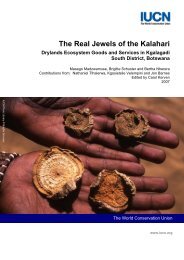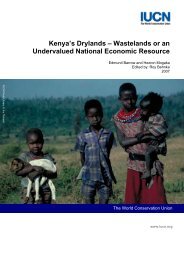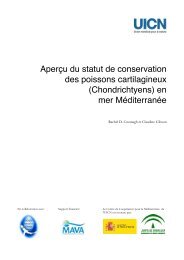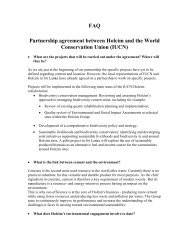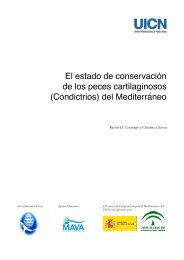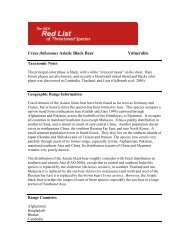iucn mediterranean sharks (pdf) - The Shark Trust
iucn mediterranean sharks (pdf) - The Shark Trust
iucn mediterranean sharks (pdf) - The Shark Trust
You also want an ePaper? Increase the reach of your titles
YUMPU automatically turns print PDFs into web optimized ePapers that Google loves.
4.7 Portuguese dogfish Centroscymnuscoelolepis (Bocage and Capello, 1864)Mediterranean: Least ConcernGlobal: Near Threatened (2003), Update in preparationMediterranean assessment authors: Clò, S. and Hareide, N.strict implementation of the GFCM deepwater trawling ban;the efficacy of this measure should be monitored and bycatchof deepwater fisheries accurately reported. If fishingexpands below 1,000m in the future, this assessment willneed to be revisited.4.8 Bigeye thresher Alopias superciliosus(Lowe, 1839)Mediterranean: Data DeficientGlobal: Not Evaluated (in preparation)Centroscymnus coelolepis is one of the deepest living<strong>sharks</strong>. It is widely but patchily distributed in the Atlantic,Pacific and Indian Oceans, living on or near the sea bottomover continental slopes and upper and middle abyssal plainrises. This species has very slow growth and lowfecundity, resulting in a very low intrinsic rate ofincrease and making it vulnerable to population declinewhere it is fished (Stevens and Correia 2003).<strong>The</strong> Mediterranean population of C. coelolepis appears tobe distributed deeper than populations in the Atlantic andPacific (Clò et al. 2002). Bottom trawl surveys indicatethat it is found from 1,301m to a maximum depth of2,863m (Clò et al. 2002; Grey 1956; Massutí and Moranta2003; Priede and Bagley 2000; Sion et al. 2004). In trawlsurveys in the western Mediterranean (Balearic Islands),Massutí and Moranta (2003) recorded this species from1,301–1,700m and Sion et al. (2004) from 1,500–2,500m.Both studies reported that C. coelolepis increased inabundance at the greatest depths surveyed. <strong>The</strong> specieswas also recorded using a video camera in the easternMediterranean at 1,500–2,500m in the Cretan Sea and at2,300–3,850m in the Rhodos Basin (Priede and Bagley2000). In February 2005 the General Fisheries Commissionfor the Mediterranean (GFCM) adopted the Decision torefrain from expanding deep water fisheries operationsbelow depths of 1,000m, which entered into force inSeptember 2005 (FAO 2005, see 6.1). <strong>The</strong> effectivenessof this measure is unknown.Although data for this species in the region are scarce,there is no evidence that the population has declined.<strong>The</strong> few data available indicate that C. coelolepis generallyincreases in abundance with depth in the Mediterranean,affording it refuge from fishing pressure. In the absenceof evidence for population declines, and given that theGFCM Decision offers it refuge from fishing pressure,C. coelolepis is considered Least Concern in theMediterranean. Although not targeted in theMediterranean Sea, any level of bycatch would be ofconcern because of this species’ intrinsic biologicalvulnerability to depletion. <strong>The</strong>refore its status will rely on theMediterranean assessment authors: Vacchi, M., Macias, D.,Fergusson, I., Mancusi, C. and Clò, S.Alopias superciliosus has been poorly documented in theMediterranean and is considered scarce or rare (Barrulland Mate 2002). <strong>The</strong>re are no available data on catch trendsfor this species in the region, although significantreductions in thresher <strong>sharks</strong> have been reported throughcatch per unit effort (CPUE) comparisons in the NorthwestAtlantic pelagic longline fishery (Baum et al. 2003), andsuspected declines have occurred elsewhere.A. superciliosus is a bycatch of the semi-industrial fisheries(swordfish and other pelagic fisheries) of southern Spain,Morocco, Algeria, Sicily and Malta, and of artisanal trammeland gillnet fisheries elsewhere in the Mediterranean Sea(Bauchot 1987). In recent years, increasing numbers ofnew records from the eastern Mediterranean (sometimesmultiple captures) demonstrate that this species alsopenetrates widely to the east of Malta, occurring in thewaters off Israel (Levantine basin), in the Aegean Sea offTurkey and southern Greece, and off southern Crete(Fergusson pers. comm; Golani 1996). Evidence fromoffshore pelagic fisheries in southern Sicily and Maltaindicate that A. superciliosus is caught in unknownnumbers each year, but routinely discarded at sea (hencethe vernacular name ‘false thresher’, because of aperceived low local value).Despite the apparent threat posed by bycatch, the lack ofrecords and further information on the population of A.superciliosus in the Mediterranean prevents an assessmentbeyond Data Deficient at this time (Vacchi et al. in prep.).This species, like many other large shark species in thisregion, poses a particular dilemma – is it rare in theMediterranean, or just rarely caught and reported? It is17



